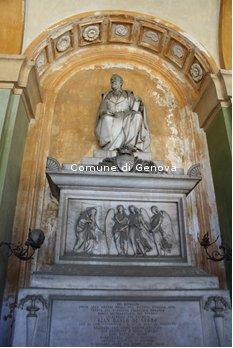This monument has been built in memory of the marquis Gio. Carlo di Negro, one of the most famous personalities of the 19th century. He has been a refined man-of-the-world, a friend and a patron of artists and literary men, a cultivated cosmopolitan and a poet, close to Giuseppe Mazzini and susceptible to the ferments of the Risorgimento.
The Villetta Di Negro, his little villa, has been built according to Carlo Barabino’s project, the cemetery’s first designer and one of the most important Genoese architect of that time, but unfortunately it was destroyed in 1942 by the bombardments and replaced with the “Edoardo Chiossone” Museum of Oriental Art; its refined romantic park is only partially conserved. Since 1805 and during its long life this villa has been an internationally renowned centre of cultural and social entertainments and a must stop for a lot of Italian and stranger intellectuals of that time, such as Alessandro Manzoni, Massimo D’Azeglio, Gioacchino Rossini, Niccolò Paganini, Madame de Staël, Stendhal, Lord Byron, George Sand, Charles Dickens and Honoré de Balzac.
This tomb which has been made by Carlo Rubatto, one of the first sculptors who have worked in the cemetery of Staglieno, has a full-length portrait of this Genoese patrician; on the sarcophagus, which bears the coat of arms and some symbols, which represent his intellectual activity (a cithara, some books and some bay wreaths) a bas-relief represents an episode taken from the Bible, i.e. Abraham receiving the three angels; it probably makes reference to the virtue of the Hospitality, which has been practiced by the deceased during his life.



